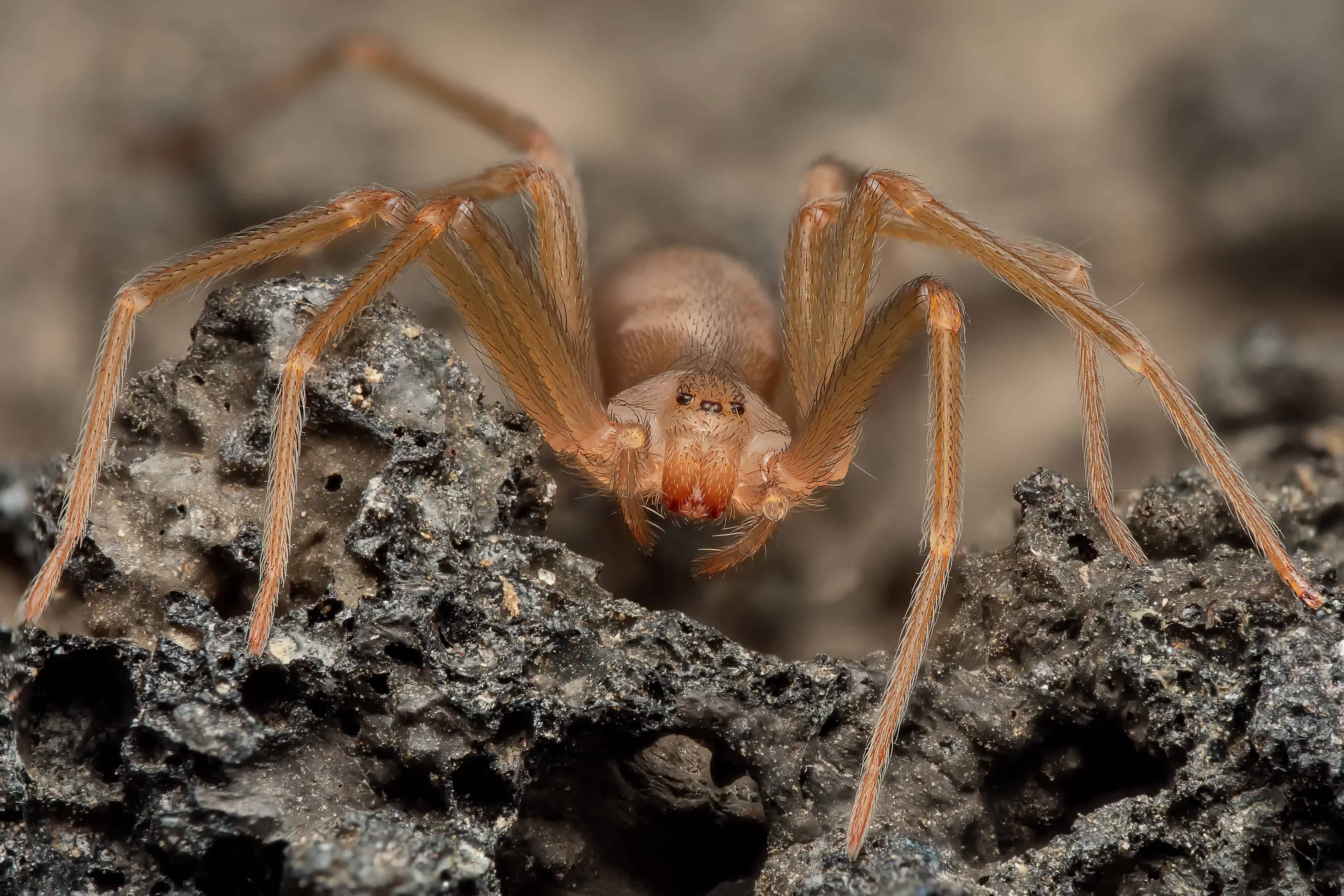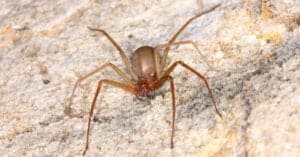There’s no doubt that spiders can make us jump! But if you’re interested in these fascinating creatures, you’re definitely in the right place. Here we’ll look at some of the tiniest spiders on Earth and explore their unique features, habitats, and size.
Arachnids are known for their striking diversity in shapes and sizes – some so small they can fit onto your fingertip. Amazingly, certain species, such as jumping spiders, can detect you from a distance across the room! Without further ado, let’s dive right in and uncover some of nature’s most amazing creatures.
1. Patu Digua
Patu digua is a unique spider species found in Colombia. It weighs just 0.0017 ounces (0.05 grams) and measures approximately 0.08 inches (2 millimeters). It’s one of the smallest spider species worldwide; smaller than a grain of rice.
The spider has black legs, a white abdomen, and yellow stripes along its sides. It inhabits tropical forests and feeds on small insects such as ants and mites. Belonging to the Symphytognathidae family, Patu digua is a fascinating species. Its male is petite, measuring only 0.43mm, making it the smallest known spider species. Due to its tiny size, it can only be identified with magnifying glasses.
This amazing creature is primarily found in the Ivory Coast of West Africa. It has an incredibly developed nervous system that covers approximately 80 percent of its body. Similarly, an impressive 25 percent of its body harbors its brain. Patu digua is a true wonder of nature and one of the most remarkable creatures inhabiting our planet.
2. Maevia Inclemens

Discovered in 1922 and later verified in 1924, this delicate arachnid is native to Eastern North America.
©Justin Starr Photography/Shutterstock.com
Maevia inclemens is a unique species of jumping spider, recognized as the smallest member of its family, which comprises almost 6,000 species. Discovered in 1922 and later verified in 1924, this delicate arachnid is native to Eastern North America. Despite its tiny size, it feeds on a diverse range of insects and arthropods, making it a highly effective predator.
This spider is set apart because males exhibit dimorphism, displaying two distinct morphologies and courtship behaviors. Jumping spiders also have a striking gender difference in size. Females reach up to 10 millimeters and males only grow to 7 millimeters.
Females can be easily identified by their white faces coupled with two red or black stripes running down the abdomen. On the other hand, identifying males is more complex. There is no consistency in the morph they will take as adults. The determining factors behind the unknown aspects of this species make it almost impossible to predict which morph a juvenile will become when it matures.
Maevia inclemens are commonly found along bike and hiking trails, specifically on poison ivy and wintercreeper. They are mainly carnivorous, feeding on a wide variety of insects, but they also supplement their diet with nectar. This highlights the vital role that even the smallest members of our global community play in maintaining the ecosystem’s balance.
3. Marpissa Muscosa
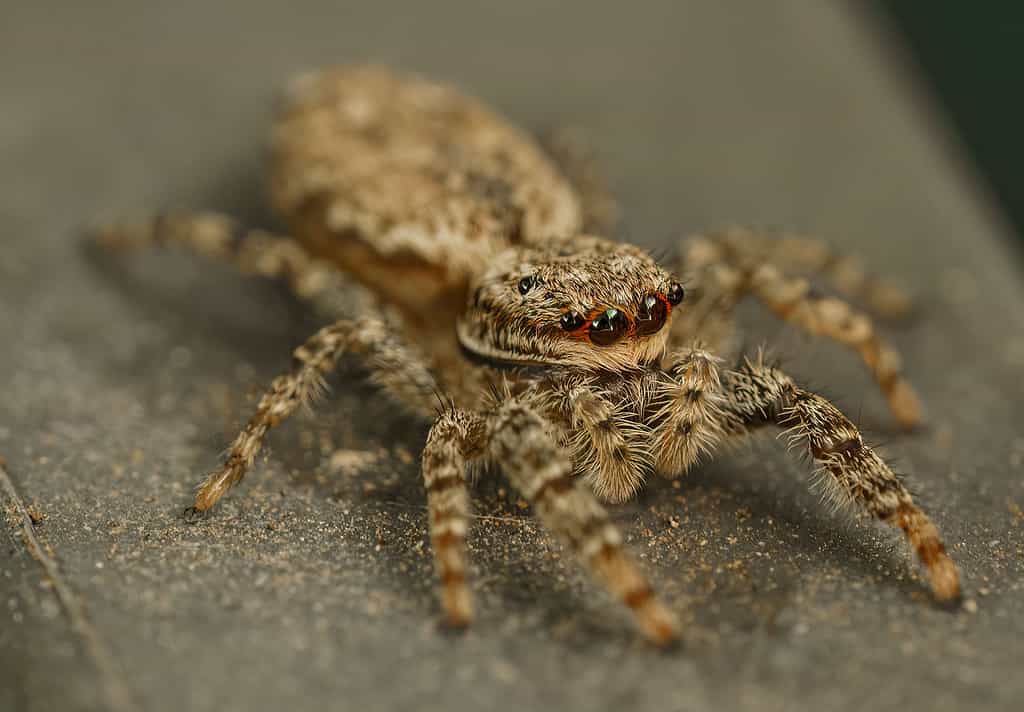
This spider is known for being an aggressive hunter. It preys on small insects such as flies, crickets, moths, beetles, and grasshoppers.
©shuttertim82/Shutterstock.com
The Marpissa muscosa is one of the most charismatic and smallest spiders in the world, measuring about 8mm in length.
It’s widely distributed in the Palaearctic region, spanning from Europe and North Africa to parts of Asia, including Russia. Its furry appearance gives it a peculiar look. And its flattened shape varies from gray to brownish, often giving it an uncanny resemblance to moss.
These small spiders usually colonize dead trees to build their nests and demonstrate social hierarchy behavior. Weaker spiders establish their inferiority by strutting their front legs. Marpissa muscosa measures just 0.15 inches long, about half the size of a penny. This spider is known for being an aggressive hunter. It preys on small insects such as flies, crickets, moths, beetles, and grasshoppers.
Interestingly, early environmental conditions shape the personality types of these developing spiders as they grow into adulthood. Marpissa muscosa not only introduces us to a cute little creature but also highlights fascinating sociological implications.
4. Ant Spider-Horse
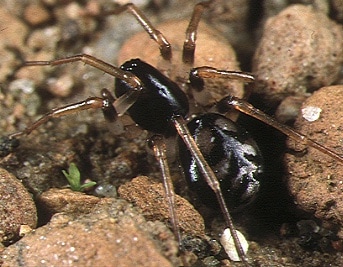
This spider originated in Gondwana.
©Akio Tanikawa / CC BY-SA 2.5, Wikimedia Commons – Original / License
The ant spider-horse is truly a marvel of nature. These tiny spiders are no more than 12mm in length and have physical characteristics resembling ants. Despite their small size, they possess an incredible ability to jump, excellent vision, and even some level of intelligence. Without these creatures, the biodiversity of our planet would be incomplete.
The ant spider-horse primarily lives off the ground, building webs above ground level between tree trunks or branches. Here, it hunts for ants or other small invertebrates. It feeds mainly on small flying insects, such as flies, mosquitoes, or moths, which it captures with its powerful jaws.
Ant spiders can be found in virtually every corner of the world. In 1975, a variation was even discovered at an altitude higher than 6,500 meters above sea level on Mount Everest. It’s believed that this invertebrate originated in Gondwana and then spread across our planet over time.
5. Tegenaria Domestica (House Spider)
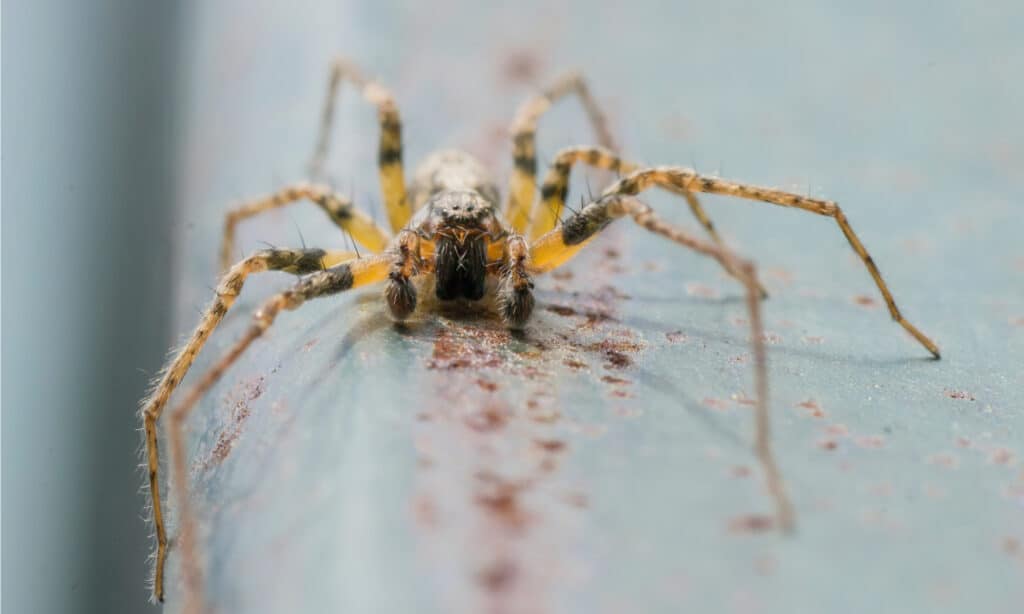
Its coloration ranges from dark brown to reddish-brown, with yellow stripes down its back.
©Korovko Gleb/Shutterstock.com
Most of us have probably heard of Tegenaria domestica, the house spider. This tiny species is an essential member of the funnel spider family. In fact, out of all its spider relatives, Tegenaria domestica is the most common. It can be found all over the world.
Its coloration ranges from dark brown to reddish-brown, with yellow stripes down its back. These stripes help it blend into its surroundings while hunting for food. Its diet consists primarily of small insects such as flies or other arachnids. It hunts using webs made up of sticky silk threads that trap prey items. These spiders can detect movement with their six forward-sighted eyes, allowing them to focus quickly on prey items.
They prefer warm climates and often end up inside homes where they build webs near windows or corners. Females measure between 7.5 to 11.5 mm in body length, while the males are smaller at 6 to 9 mm. Among many other features, male T. domestica are easily identified by their elongated abdomens and bloated pedipalps. They also possess longer, more agile legs than females.
Young T. domestica hatch from an egg sac and mature within a year. They are one of the fastest-growing species in the funnel spider family. Generally, male numbers peak during the summer months of June and July. They usually die off soon after mating in autumn, rarely living for over a year.
Even more astonishingly, freshly mated females have been observed eating their male partners! Usually only the females survive through winter into the next year, making them incredibly suitable companions for your home. These house spiders rarely pose any danger to humans but will defend themselves under threat.
6. Pholcus Phalangioides

These long-bodied cellar spiders can be found worldwide in undisturbed, low-light locations like basements, under stones, ledges, and caves.
©Marek Velechovsky/Shutterstock.com
Meet Pholcus phalangioides, the daddy-long-legs spider from the Pholcidae family. These spiders make this list for their body size only. Their legs can actually grow to be quite long! These long-bodied cellar spiders can be found worldwide in undisturbed, low-light locations like basements, under stones, ledges, and caves. They are easily identifiable by their large, flat, irregular webs. They can often be seen living on ceilings or corners when they make their way into homes.
These spiders have tiny pale yellow-brown bodies and legs that are nearly translucent and covered in fine gray hairs. Upon closer inspection, they have a slightly darker color around their eight eyes, which consist of two small ones in front of two larger triads. Their body is small, with males reaching only 6mm and females reaching 7-8mm.
Under a microscope, their translucent quality allows us to observe moving cells within their legs and bodies. Males seem to prefer larger females capable of producing more eggs. During mating, which can last for several hours, the male deposits sperm into the female’s epigyne. After laying her eggs, the female wraps them tightly in a silk strand for protection.
These tiny spiders can live up to three years. They primarily feed on other spiders and small insects, which they kill and digest by injecting venom. As remarkable as these tiny creatures are, they can engage in cannibalism, with male and female pholcids known to participate. However, when threatened, they quickly camouflage themselves by flapping their legs around, making them hard to spot.
7. European Garden Spider (Cross-Legged Spider)
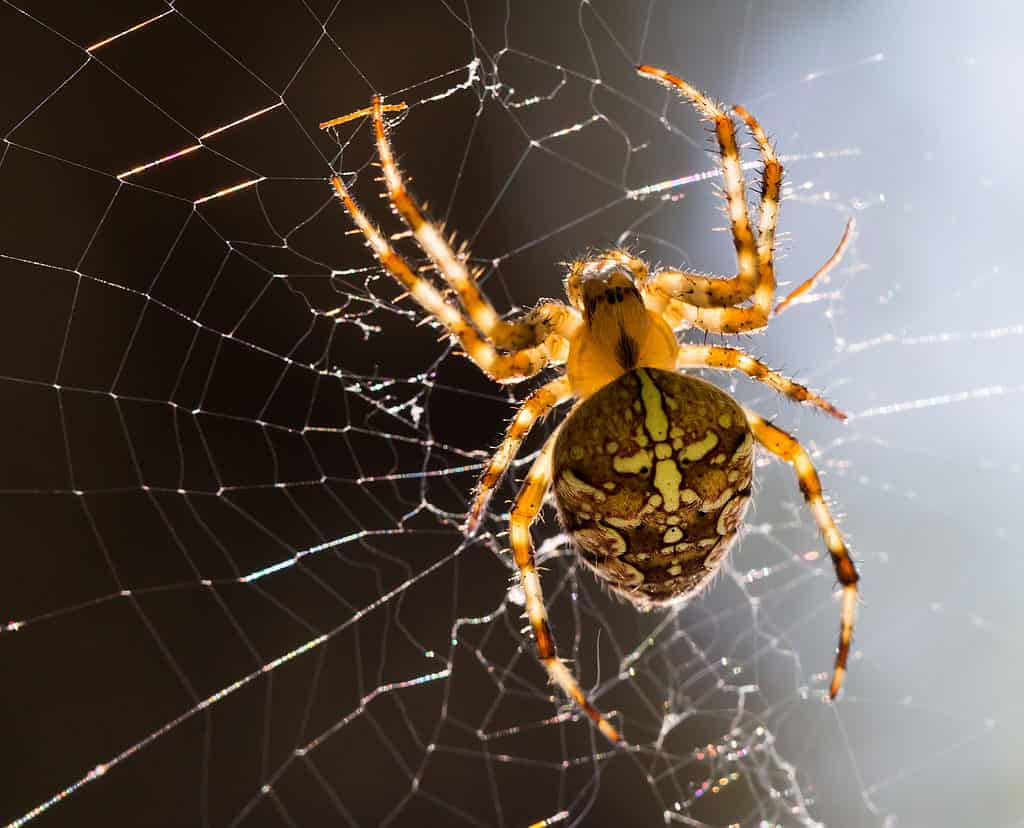
These small spiders range from light yellow to orange-brown or dark grey.
©iStock.com/Iuliia Iunzhakova
The European garden spider, also known as the cross orb-weaver or diadem spider, belongs to the family Araneidae. This family consists of orb-weaving spiders and is well-known in Western Europe.
These small spiders range from light yellow to orange-brown or dark grey. Additionally, they have a unique cross symbol on their backs. On average, adult females measure anywhere from 6.5 to 20 millimeters long, while males measure 5.5 to 13 millimeters.
Despite their little size, European garden spiders remain recognizable in European gardens and homes. This incredible spider species is common in many habitats, such as hedgerows, woodland clearings, gardens, and meadows. They also pack a robust appetite, feeding primarily on smaller species of flying insects, such as flies and mosquitoes. They do so by trapping them in their elaborate webs.
When prey become entangled in the web, their vibrations attract the spider. The garden spider will then swiftly deliver a paralyzing bite before proceeding to wrap the insect in silken strands. This fascinating process regularly occurs in our homes, providing us with a unique insight into the world of spiders.
From late summer until autumn, adults of the species are readily found. Females leave their webs in September and look for sheltered places to lay between 300-900 eggs. They lay these eggs within a protective yellow cocoon of silk threads formed into a hemisphere. Common sites chosen by female spiders include underneath dead tree bark and cracks and crevices.
8. Latrodectus Tredecimguttatus (Mediterranean Black Widow)
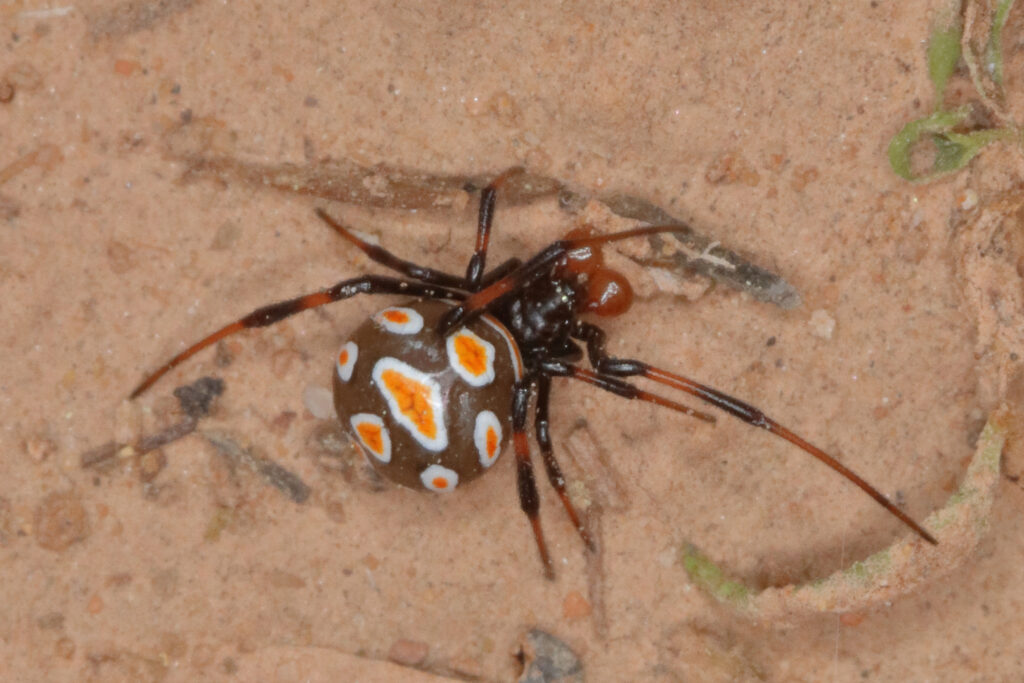
This arachnid’s characteristic coloration sets it apart from other spider species. It has red spots on its abdomen.
©iStock.com/Frank Buchter
Latrodectus Tredecimguttatus, also known as the Mediterranean black widow or European black widow, is among the smallest spiders in the world.
This arachnid’s characteristic coloration and predatory behaviors set it apart from other spider species. It has red spots on its abdomen, though adult females sometimes lack them and appear solid black. Additionally, females are known to consume their partner after mating, a practice unique among spiders. All these features make this invertebrate unique.
Found in many steppes and grasslands, this species is a member of the Latrodectus. It stands out thanks to its dorsal abdomen, which has 13 distinct red spots. Some varieties may feature yellow or orange spots instead. However, both sexes can be pretty small. Females reach a maximum length of 7-15 mm and males reach 4-7 mm.
The male does not possess venom glands, nor can its fangs penetrate a thick epidermis. However, the females are venomous; this spider’s bite has been known to harm humans and livestock alike. Studies have shown that 0.59 mg/kg of L. tredecimguttatus venom can be lethal. Thus, despite their size, these spiders remain one of nature’s most dangerous creatures. It is essential to use caution when encountering these diminutive creatures in their natural environment.
9. Brown Recluse Spider

These spiders typically measure between 0.5 and 1 inch in length and have six eyes arranged in pairs.
©Physics_joe/Shutterstock.com
The brown recluse is also known as the fiddle back or violin spider due to the mark on its back. This spider is infamous in many American states. These spiders typically measure between 0.5 and 1 inch in length and have six eyes arranged in pairs. They thrive primarily in warm and dry environments and often lurk undisturbed in attics, closets, and basements.
Brown recluse spiders are known for their ability to thrive in adversity. Although their average lifespan is only one to two years, this species can withstand extreme drought and lack of food for up to six months without any harm. Females can lay up to 50 eggs in multiple sacs during the spring, which hatch within a month. They take another year to mature fully. Researchers have observed larvae surviving five seasons without food while held captive, proving this species’ extraordinary resilience.
Brown recluse spiders are nocturnal and prefer to feed on insects such as cockroaches and crickets. These spiders generally shy away from humans but may accidentally bite. This can happen if they feel threatened or come into contact with someone through clothing or bedding.
Their bites can lead to severe symptoms such as fever and skin necrosis, so it’s vital to seek medical attention. Fortunately, most people never experience a brown recluse spider bite because they are rare.
The Fascinating Smallest Spiders’ World
The tiniest spiders in the world offer a fascinating glimpse into an often-overlooked aspect of nature. A closer look at these tiny arachnids can inspire a newfound appreciation for their refined elegance and resilience. In addition, these minuscule creatures have significant value in our lives.
For instance, certain tiny spiders are known to naturally control insect populations by preying on them for sustenance. It’s worth noting that they also contribute to critical ecological functions, such as promoting soil fertility. Ultimately, learning about the world’s most miniature spiders provides numerous opportunities to delve into and appreciate nature more deeply.
Summary of The 9 Smallest Spiders in the World
Here are the nine smallest spider species in the world:
| Rank | Smallest Spiders |
|---|---|
| 1 | Patu Digua |
| 2 | Marpissa muscosa |
| 3 | Marpissa Muscosa |
| 4 | Ant Spider-Horse |
| 5 | Tegenaria domestica (House Spider) |
| 6 | Pholcus Phalangioides |
| 7 | European Garden Spider (Cross-Legged Spider) |
| 8 | Latrodectus tredecimguttatus (Mediterranean Black Widow) |
| 9 | Brown Recluse Spider |
Thank you for reading! Have some feedback for us? Contact the AZ Animals editorial team.

